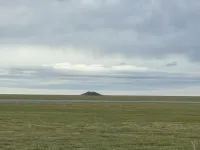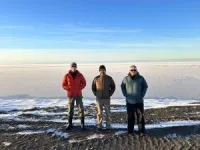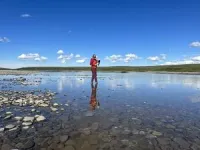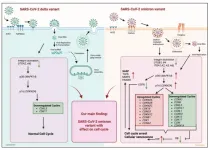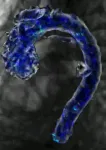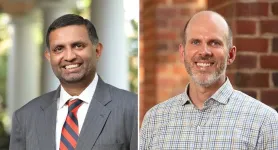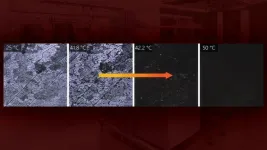(Press-News.org) ALBUQUERQUE, N.M. — The Arctic is remote, with often harsh conditions, and its climate is changing rapidly — warming four times faster than the rest of the Earth. This makes studying the Arctic climate both challenging and vital for understanding global climate change.
Scientists at Sandia National Laboratories are using an existing fiber optic cable off Oliktok Point on the North Slope of Alaska to study the conditions of the Arctic seafloor up to 20 miles from shore. Christian Stanciu, project lead, will present their latest findings on Friday, Dec. 15 at AGU’s Fall Meeting in San Francisco.
Their goal is to determine the seismic structure of miles of Arctic seafloor. Using an emerging technique, they can spot areas of the seafloor where sound travels faster than on the rest of the seafloor, typically because of more ice. They have identified several areas with lots of ice, said Stanciu, a Sandia geophysicist.
The scientists also used the cable to determine temperatures over the stretch of seafloor and monitored temperature changes over seasons. These data, unlike any collected before, were inserted into a computer model to infer the distribution of submarine permafrost, said Jennifer Frederick, a computational geoscientist.
“One of the innovations of this project is that we can now use a single fiber to get acoustic and temperature data,” Stanciu said. “We developed a new system to remotely collect both types of data using one fiber strand. We’re getting some interesting results.”
Permafrost and bouncing light
Like leftover roast turkey sitting in the back of the freezer since Thanksgiving, Arctic permafrost is a banquet just waiting to be thawed. Specifically, as the once-living matter that was frozen during the last ice age thaws, microbes begin to digest it and produce waste gases such as methane and carbon dioxide, Frederick said. Scientists are studying just how large a microbial banquet lies frozen in the Arctic and how large of an impact those gases could have on the global climate.
To study permafrost on the Arctic seafloor, the researchers used pulses of laser light shot down a submarine telecommunications fiber optic cable buried off the coast of Alaska, running north from Oliktok Point. Tiny imperfections in the cable caused light to bounce back to a sensor system. By capturing this light at two wavelengths, or colors, and comparing them, the researchers could determine the temperature of the cable every yard, Frederick said. This is called distributed temperature sensing.
By looking at light of a different wavelength the researchers could detect when the cable had been strained by a passing sound wave. This so-called distributed acoustic sensing provided information about the structure of the seafloor to depths of one to three miles, Stanciu said.
Using this method, the scientists believe they have identified the bottom of the seafloor permafrost at around a quarter of a mile deep. They also found another area with unusually large amounts of ice, possibly consistent with a pingo or “ice pimple,” a domed hill formed by ice pushing upwards, he added. The data analysis for the measurements was done principally by Sandia intern Brandon Herr.
“The fact that we can monitor the temperature continuously, we can now pick up changes from year-to-year and season-to-season,” Frederick said. “We’re specifically looking for unexplainable warm spots. We think we’ll be able to see areas of seafloor seeps — somewhat like springs coming out of the ground, except on the seafloor. We’re interested in them because they’re carriers of deeper, carbon-rich fluids and are an indication of warming and change.”
History and innovations
Sandia has been collecting climate data from northern Alaska for more than 25 years. The current research project started about a year ago and builds off prior work on the same fiber optic cable by Sandia geophysicists Rob Abbott and Michael Baker. This project is funded by Sandia’s Laboratory Directed Research and Development program.
One recent innovation from Stanciu’s team is a fully operational system that allows near-real time remote data collection. This minimizes time and cost of travel to Oliktok and the risk of losing data when the system is unattended, Stanciu said. Acoustic and temperature data cannot be collected at the same time, but one or the other now can be collected continuously.
One challenge the team solved during the first year of the project was determining how to calibrate temperature data from the fiber optic cable, Frederick said. Typically, distributed temperature sensing systems are built with self-check systems such as fiber that doubles back on itself for redundancy or with built-in thermometers. However, since the team is using a telecommunications dark fiber, they needed computational models to validate the seasonal temperature changes they detected. The data analysis for this was done principally by Sandia intern Ethan Conley.
Frederick uses the data from the distributed temperature sensing and the results from the distributed acoustic sensing modeling to provide constraints to a geophysical modeling code developed by Sandia. The code models liquids and gases flowing through soils underground. Frederick uses this code to model 100,000 years of geologic history for the studied stretch of Arctic seafloor, including the average temperature of the most recent ice age and how much the sea level has risen. The results of the model are maps of the current distribution of submarine permafrost.
Limitations of the interrogator system the team uses, including the power of the laser and sensitivity of the sensors, keep the scientists from collecting data more than 18-25 miles offshore, Frederick said. With improvements to the system, she hopes to push the distance out farther.
“This project has many different pieces,” Frederick said. “I’m looking at temperature and Christian is looking at acoustics to get a subsurface model. Really you need all of these pieces to say something about the larger picture of the current distribution of permafrost and whether we are seeing changes like seeps and how that plays into the larger greenhouse gas emissions picture. Being able to use new tools and push them to their extreme to see what we can learn is really cool.”
END
Using a fiber optic cable to study Arctic seafloor permafrost
2023-12-15
ELSE PRESS RELEASES FROM THIS DATE:
A unique pathogenic mechanism of SARS-CoV-2 omicron variant: Selective induction of cellular senescence
2023-12-15
“Our findings suggest that the omicron variant, in particular, leads to premature senescence in in vitro, ex vivo, and in lung tissue models.”
BUFFALO, NY- December 15, 2023 – A new research paper was published on the cover of Aging (listed by MEDLINE/PubMed as "Aging (Albany NY)" and "Aging-US" by Web of Science) Volume 15, Issue 23, entitled, “Uncovering a unique pathogenic mechanism of SARS-CoV-2 omicron variant: selective induction of cellular senescence.”
SARS-CoV-2 variants are constantly emerging with a variety of changes in the conformation of the spike ...
UChicago Medicine among the first in the country to offer newly approved sickle cell gene therapies
2023-12-15
The University of Chicago Medicine Comer Children’s Hospital will be among the first in the country to offer gene therapy for sickle cell disease in patients 12 years and older, after federal regulators approved two new treatments on December 8, 2023.
Thousands of patients with sickle cell disease experience vaso-occlusive crises (VOCs), which are often painful and frequently require hospitalization. The two new potentially curative treatments show promise for eliminating VOCs and offer an alternative to bone marrow transplants, which can be arduous and carry risk of rejection even if a matching donor is found.
People ...
Unstable ‘fluttering’ predicts aortic aneurysm
2023-12-15
Northwestern University researchers have developed the first physics-based metric to predict whether or not a person might someday suffer an aortic aneurysm, a deadly condition that often causes no symptoms until it ruptures.
In the new study, the researchers forecasted abnormal aortic growth by measuring subtle “fluttering” in a patient’s blood vessel. As blood flows through the aorta, it can cause the vessel wall to flutter, similar to how a banner ripples in the breeze. While stable flow predicts normal, natural growth, unstable flutter is highly predictive of future abnormal growth and potential rupture, the researchers found.
Called ...
Microbiome insights found in poop help predict infections in liver transplant patients
2023-12-15
In a new study, researchers at the University of Chicago were able to predict postoperative infections in liver transplant patients by analyzing molecules in their poop. Their analysis represents a key leap forward in exploring the connection between the gut microbiome — the bacteria that inhabit the human body — and overall health.
“Antibiotic resistance is growing every year and getting worse. Without antibiotics that work, we can't do things like perform surgeries, protect premature infants or treat cancer,” said Christopher Lehmann, MD, ...
A new tool to better model future wildfire impacts in the United States
2023-12-15
SAN FRANCISCO – Wildfire management systems outfitted with remote sensing technology could improve first responders’ ability to predict and respond to the spread of deadly forest fires.
To do this, researchers at The Ohio State University are testing the use of Synthetic Aperture Radar, or SAR, to help with wildfire detection.
For many ecosystems, fires are vital tools that help to clear away plant waste, provide safer habitats for smaller species and burn off disease. Yet as Earth continues to experience warmer, drier conditions, the likelihood and severity of large, uncontrolled fire incidents that result in widespread ...
Navigating climate challenges: UVA engineers and environmental scientists aid Virginia’s eastern shore
2023-12-15
Because of warming waters and melting glaciers, the sea level at Virginia’s Eastern Shore has risen almost 3 inches since 2016, and the projected trajectory looks ominous. The region, sandwiched between the Chesapeake Bay and the Atlantic Ocean, has one of the highest rates of relative sea-level rise on the Atlantic coast. The Virginia Institute of Marine Science’s Center for Coastal Resource Management projects a relative sea-level rise between 4.5 to 7 feet by 2100, which is three to four times the global average.
Hampton, Virginia — its neighbor across the bay — ranks second only to New Orleans as the largest population center ...
Using AI to pinpoint hidden sources of clean energy underground
2023-12-15
SAN FRANCISCO – As efforts to transition away from fossil fuels strengthen the hunt for new sources of low-carbon energy, scientists have developed a deep learning model to scan the Earth for surface expressions of subsurface reservoirs of naturally occurring free hydrogen.
Researchers used the algorithm to help narrow down the potential whereabouts of ovoids or semicircular depressions (SCDs) in the ground that form near areas associated with natural or “gold hydrogen” deposits. Though these circular ...
A study from IMDEA Software researchers reveals hidden fortunes and surprising overestimations in cybercrime revenue
2023-12-15
To what extent methodological limitations and incomplete data impact the revenue estimations of cybercriminal groups using the Bitcoin blockchain was largely unknown. A new study, conducted by IMDEA Software Institute researchers Gibran Gomez, Kevin van Liebergen, and Juan Caballero challenges existing figures regarding cybercriminals' Bitcoin earnings to date. The study, entitled "Cybercrime Bitcoin Revenue Estimations: Quantifying the Impact of Methodology and Coverage", recently presented at the ...
Department of Defense grant boosts study of pressure, humidity on thermal energy storage
2023-12-15
Under the Defense University Research Instrumentation Program, Dr. Patrick Shamberger and a research team from the Department of Materials Science and Engineering received a grant from the U.S. Department of Defense (DOD) to acquire instrumentation for thermal energy storage research.
The grant, administered through the Office of Naval Research, will support the acquisition of a high-sensitivity multi-modal calorimeter for advanced research and education on tunable energy storage materials. This equipment will allow cutting-edge research to study the capability of pressure and humidity to control how well these materials can store ...
IU researchers fill the final gaps in the Arabidopsis genome sequence and gain insights into gene regulatory mechanisms relevant to humans
2023-12-15
Arabidopsis thaliana is a species grown worldwide for genetic research and was the first plant to have its complete set of chromosomes (its genome) sequenced. The initial genome sequence, released in the year 2000, had numerous gaps, but technological improvements in the years since closed the gaps, one by one, until only two remained: large undefined regions on chromosomes 2 and 4 where genes encoding ribosomal RNAs are repeated in hundreds of copies. These ribosomal RNA gene clusters, known as nucleolus organizer regions (NORs), are not just difficult to define in Arabidopsis; gaps remain at ...
